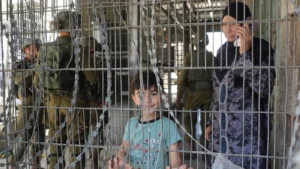How Israel’s ‘gates’ have become tools of psychological control

A Palestinian child stands at an Israeli checkpoint in Hebron
Samah Jabr writes in Middle East Eye on 13 October 2025:
I write with profound distress about the latest development in the machinery of control suffocating Palestinian life.
Ominous yellow iron structures connecting two huge blocks of cement, wrongly referred to by many as “gates”, have multiplied across the occupied West Bank. I call them ominous because they provoke a deep, dreadful anticipation – a response to threats of further ethnic cleansing and land theft in Palestine.
Surely they are not gates. A gate opens a wall; it implies entry, passage, possibility, an exit, a path forward. These are carceral structures turning our small neighbourhoods into cages in both the occupied West Bank and Jerusalem. They are deliberately designed to isolate, obstruct, disable and suffocate.
Just last week, a mother coming from Jerusalem called my clinic in tears. She had prepared her 12-year-old son for a long-awaited therapy session, but Israeli soldiers kept her waiting at one of these iron chokepoints for three hours. By the time she arrived, I was out of the clinic. Her son, already struggling with anxiety, sobbed uncontrollably in the backseat of the car, saying he would never try again.
This small story is multiplied hundreds of times across the occupied West Bank every single day.
Fragmenting Palestinian life
The numbers tell a grim story. Since October 2023, hundreds of new carceral structures have been erected across the occupied West Bank, bringing the total number of movement obstacles to nearly 1,000. In East Jerusalem alone, more than 80 checkpoints and carceral structures form a mesh of steel meant to fragment Palestinian life into disconnected pockets.
The consequences are devastating. Closures have increased poverty; two weeks ago, when 22-year-old labourer Sanad Hantouli from Jenin scaled the separation wall in an effort to reach Jerusalem – carrying only a bag of clothes, and hoping to find work to feed his family – Israeli soldiers shot him dead.
In some villages, ambulances have been delayed so long by these structures that patients have died before reaching medical care. These are not accidents; they are the predictable results of policies that enforce isolation and immobility.
These structures are not new inventions. They are the continuation of decades of a colonial architecture of control.
Since the Oslo Accords, movement in the occupied West Bank has been increasingly strangled by closures, permits, walls and “security” justifications. What we are witnessing now is an intensification of the same logic, with a goal to fragment the land, dismember its social fabric, and make daily life unbearable, so that people feel alienated and eventually surrender or leave.
These structures deliberately disrupt the basic rhythm of human life, engineering dysfunction within Palestinian communities
This tool of suffocation has now reached al-Ram, the northern Jerusalem neighbourhood where my psychiatry clinic is located. My clinic, serving a large population from the occupied West Bank and Jerusalem, exists to help people recover; to support them in regaining purpose and meaning in their lives.
But the carceral structures erected around al-Ram derail that journey. While I work with patients to restore their ability to recover from distress and trauma – to study, work and care for their families – these structures deliberately disrupt the basic rhythm of human life, engineering dysfunction within Palestinian communities.
The irony is painful. Inside the clinic, I strive to ease panic attacks, lift depression and give hope to those who suffer. Outside, the carceral structures amplify anxiety, obstruct hope and impose new layers of distress.
How does it feel for a patient struggling with panic attacks to be trapped at such a structure, late for therapy? What does it mean for someone with depression and depleted energy to find even their journey to therapy blocked, their movement dictated by a lock and a soldier’s whim?
Chronic uncertainty
Psychologically, these structures create chronic uncertainty and arbitrariness. Patients describe the dread of approaching a “gate”, not knowing whether it will open or remain closed for hours.
Children learn early that their lives are subject to the push of a button in a soldier’s hand. Over time, such uncertainty erodes a person’s sense of agency. Therapy requires routine and predictability, yet the occupation enforces chaos. Even the anticipation of being stopped makes some people give up and not even try to leave their homes.
